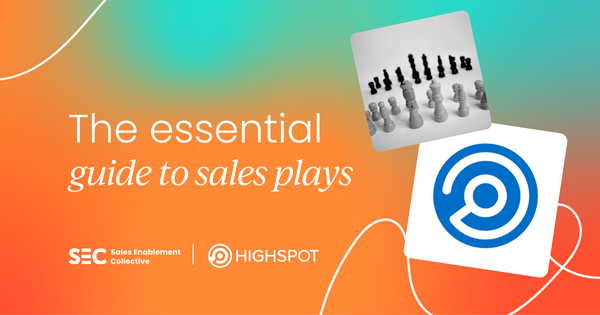If you want to get sellers to do something that is new or different, you need to be specific about exactly what it is you want them to do.
Yet, in many organizations, this direction isn’t clear.
Consider how your organization shows sellers what an effective first meeting looks like. If you are like many customers we speak with, you might do something like this:
- You publish the official first meeting slides in your content management system, but sellers still struggle to find them.
- The slides don’t show sellers how to ask effective discovery questions. Instead, discovery questions are listed in a separate document that sellers can never find when they need it, and it’s unclear how sellers should fold these discovery questions into the first meeting slide deck.
- Sellers want peer examples but have to search through calls in your call recording system to find them.
- Marketing has created assets to use as follow-ups to the first meeting, but they sit in a different repository and are rarely used in practice.
All of these are common. They boil down to two main issues:
- Sellers don’t have a single place to find what they need.
- The organization never communicated what “good” looks like, needlessly forcing each salesperson to invent their own version of “good” for their sales calls.
Consider this analogy
Stepping out of the world of sales for a moment, imagine you and your friend are leading two groups of 12-year-old scouts, each with a goal of climbing a mountain on their own.

You, being organized, select all the gear each scout will need, lay it out in organized piles, and arm each scout with a detailed map and guidebook that describes the trail.

Your friend, who has recently been a bit frazzled, dumps what appears to be the entire contents of his garage into a large pile at the trailhead.
He tells each scout to pull out what they think they need, sorting necessary items from a mountain of 30-year-old sporting equipment and occasional bits of gardening gear. Also, he has forgotten the maps, guidebook, or compass.
Each scout will have to find their own way. Which group is likely to see more scouts safely summit?
This example may sound absurd but the frazzled friend, unfortunately, is a close representation of the way many companies equip their sellers. A few experienced, talented, or lucky folks will achieve their goals, but many will get lost in the woods.
Even when the pile of content we give our sellers contains some true gems, if our team can’t find them and doesn’t understand when and how to use them, they are unlikely to succeed.
The Modern Sales Play is the answer to this challenge.
It pulls together all that a seller needs to know, say, show, and do in a particular situation in a consistent, easily digestible format.
The modern sales play bears little resemblance to the sales playbooks of old. Remember the three-ring binders that were printed at great expense and handed out at training sessions, only to gather dust on a shelf?
Or, perhaps, the 80-page PDF that still lurks in a corner of your sales portal?
While those tomes were often very comprehensive, they had many challenges:
❌ They were overwhelming and hard to navigate.
❌ They were extremely expensive to evolve, so they quickly went out of date.
❌ They described the theory of how deals were supposed to happen, but often the reality was very different, and the recommendations weren’t useful for sellers trying to get something done.
By contrast, the modern sales play serves as a “quick reference guide” that makes it easy for the seller to find what they need and take action. Modern sales plays do the following:
✅ Are built to serve the seller, with a clear call to action.
✅ Live where the seller works—often directly in the CRM system.
✅ Are built in digestible, bite-sized elements.
✅ Include the specific assets and tools sellers need to do their jobs.
✅ Provide real examples—via recorded calls or videos—of top performers doing whatever it is that the seller needs to do.
The play must be built to meet the needs of the seller. Not Management, not Marketing, not Enablement, but the seller specifically.
Building a play that does this well typically requires collaboration across functions. For many plays, it helps to have a representative from the sales organization included on the team who is building the play.
Elements of an effective sales play
The Hook
A seller should be able to quickly determine if the play will be useful for their situation, figure out how the play might help them, and recognize why the thing being described in the play is important to them personally and to the business.
What to Know
The play summarizes or provides links to training content and other assets that give the seller the knowledge and information they need to succeed. Common examples include:
- Product training
- Skills training
- Buyer personas
- Industry backgrounders
- Competitor battle cards
- Value frameworks
What to Say
Show the seller how to have the customer conversation that you’d like them to have. Some plays include lists of talking points or discovery questions.
More advanced plays will include a conversation flow, such as one that shows how to navigate a dialogue, offering the customer insight and asking questions. Many sellers find it very valuable to watch examples of their peers having conversations.
Recordings of actual customer calls can be invaluable here. We’ve seen other customers embed clips of top sellers offering pointers on how to have a particular conversation.
You are not trying to make the conversation a paint-by-numbers exercise, but you are trying to remove guesswork for the seller. Each seller shouldn’t have to reinvent the wheel of what a good conversation sounds like.
What to Show
This section has links to customer-facing assets and collateral that the seller should use to support the conversation. Examples include:
- Presentation decks
- Demo assets
- Whiteboard flows
- Pitch templates
What to Do
This section should highlight specific actions you want your sellers to take following the meeting.
Those actions might be anchored in an internal process (“submit a list of accounts that are qualified by X date”) or may focus on follow-up actions with the customer, such as sharing a relevant piece of thought leadership content.

Kinds of sales plays
Sales plays come in different forms to meet different organizational needs.
There is no single “best” kind of play to build. Rather, organizations will typically build different kinds of plays to serve different purposes.
From their simplest form (we refer to this as a sales kit) to the more complex types of sales plays, they all act as effective tools to enable sellers and help eliminate the guesswork of trying to find and use key content and information to drive results.
Curate materials using sales kits
The simplest sales plays, or “sales kits,” simply gather all the relevant assets and training materials about a topic in a single place. This curated collection provides a one-stop shop for sellers who need to be aware of the topic and find information on it.
Sales kits have a broad range of applications, including:
- Organizing competitive information.
- Organizing materials that support specific demand gen campaigns.
- Pulling together all the assets related to a product launch.
- Helping sellers find internal operational content, such as CRM stage definitions, opportunity-tracking processes, and deal-quoting processes.
Where possible, we recommend that you build these kits with a particular audience in mind. For instance, if the sales kit supports a product launch, what information is relevant to a new business sales team vs. a post-sales support team?
Drive seller actions with sales plays
For many initiatives, however, sellers will need more than a collection of assets. They’ll crave more context about what they’re being asked to do, why, and what “good” looks like. This is where more robust sales plays come in.
These sales plays are sometimes written at the level of an initiative (such as cross-selling a new product) and other times focus on a specific action (such as how to introduce the product being cross-sold to an existing customer of a different product line).
Being specific facilitates change
When a sales play is being used to drive or change a high-impact behavior, we find that it helps to be very specific and action-focused in the sales play. Consider the example of a company that has launched or acquired a new product that is expected to be a major revenue driver for the business.
Cross-selling the product is essential to the company’s growth strategy. Many companies would be tempted to put together a play that includes the following:
- An overview of the product and its value proposition.
- A description of the target customer.
- Information about competitors in the space.
- Details about pricing and packaging.
All of this is important information for the seller, but it doesn’t tell them what to actually do or how to do it. Every seller is left to their own devices to figure out how and when to initiate a conversation with a customer about this new product.
By contrast, an action-based play will zero in on that first conversation. It will, of course, include the other background information listed above, but it will provide specifics about how to take the first steps in a sales engagement.
This is a behavior that the seller can practice and that managers can inspect and coach. It is much easier to drive change on specific behaviors than on broad initiatives.
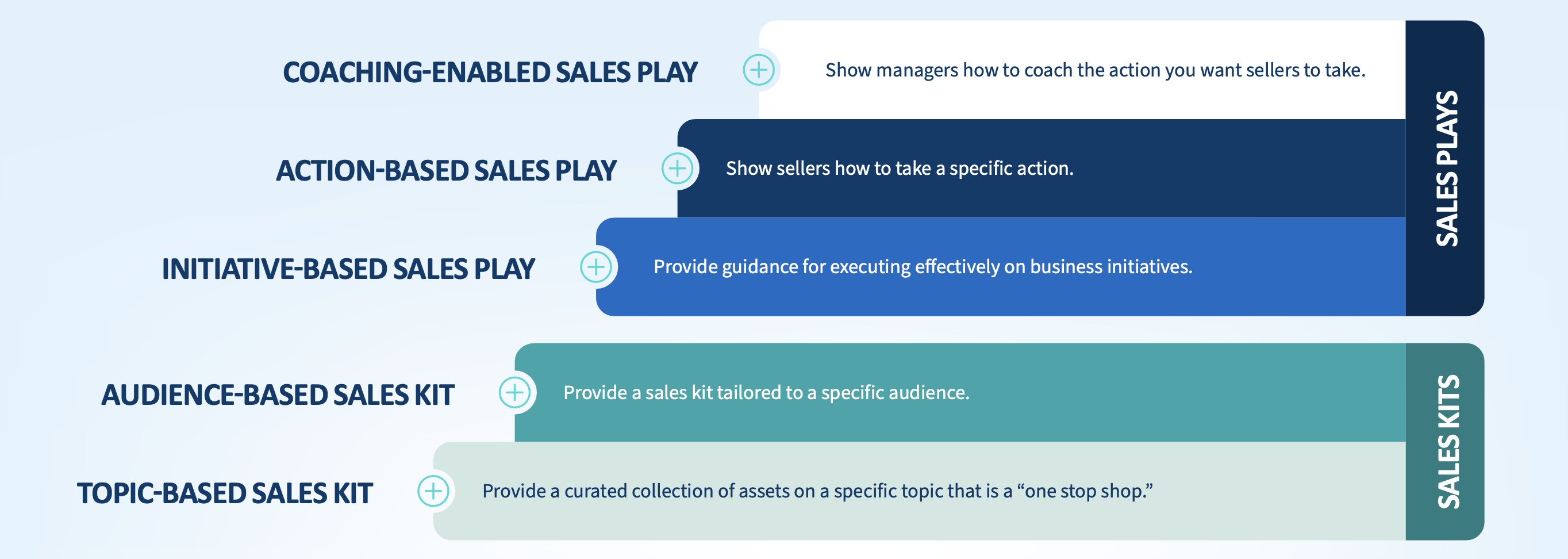
Coaches need guidance, too
To take this concept one step further, we’ve also seen companies create coaching plays for their managers. These plays accompany the seller-facingplay and provide managers specific information about what they are expected to inspect and how to help their sellers master the new action.
Just as a sales play demystifies what good selling looks like, a coaching play pulls back the curtain on effective coaching in a specific situation.
A “coaching-enabled sales play” includes both an action-based play for sellers and an accompanying coaching play for their managers.

Invest thoughtfully to maximize impact
As companies build sales plays, they often fall into the trap of “spreading the peanut butter too thin.” Enablement and Marketing are often asked to do many things, but some of those things are much more valuable than others.
To drive business impact, enablement must make sellers more effective. Doing so typically hinges on driving a small number of high-impact behaviors.
It’s critical that the sales, enablement, and marketing teams have the space to focus on these initiatives and fully operationalize the required behavior change.
For example, if the company is rolling out new value-based messaging to support a first meeting that is expected to deliver an increase in the company’s win rates, the company must rigorously execute on equipping, training, and coaching its sellers to effect the needed behavior change. A coaching-enabled play is designed for this.

But what about all the other things that the enablement team is asked to roll out? What about the minor product launches, marketing campaigns, and education on the latest tool or process? Those things need to be served.
But they should be served in a way that is not overly distracting for sellers, their managers, enablement, or marketing. Nobody is well served by driving accountability for reading the details of the latest release notes ... or building an overly complex play to support a minor change in the sales process.
Sales kits are perfect for these situations. They are quick to build and simple to consume.

Measuring adoption
At a basic level, you can measure adoption of a sales play in terms of who has read the play and how much time they spent reading it.
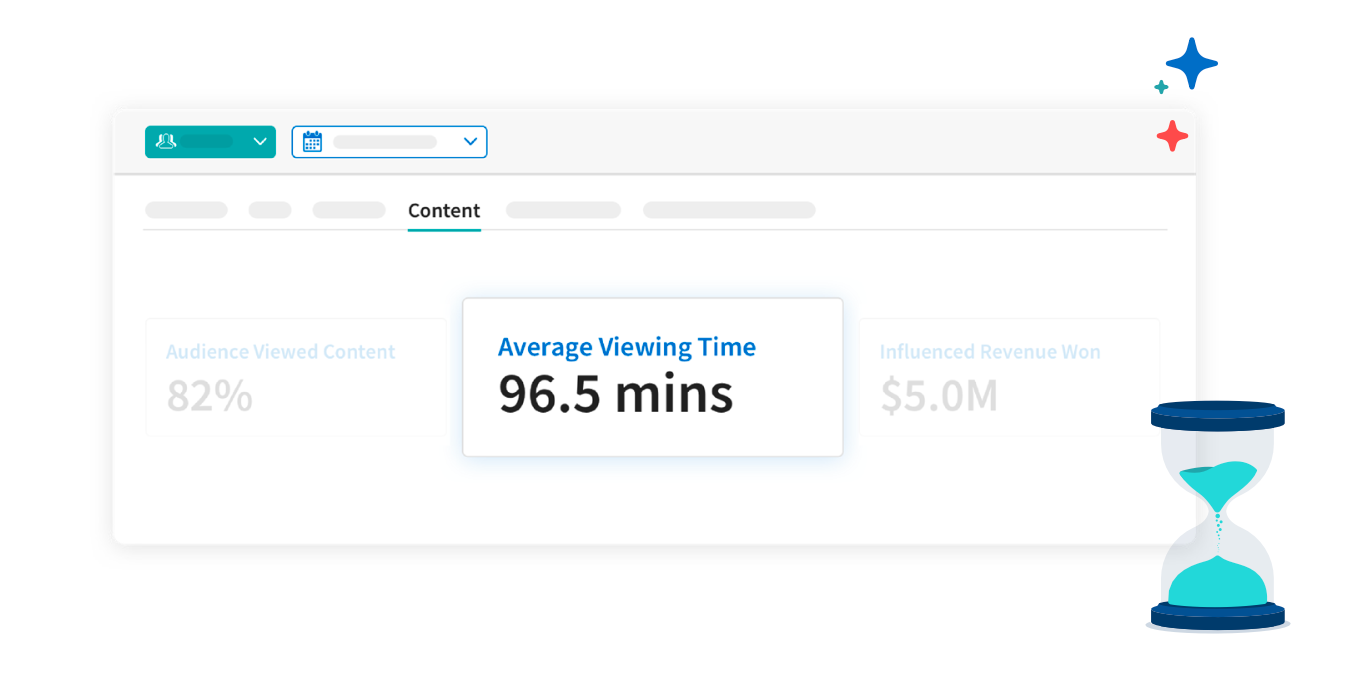
We find value in looking at this metric across each type of sales play and sales kit, though you’ll likely have different expectations depending on your goals. Consider the following:
- The information in action-based or coaching-enabled sales plays is typically “must know.” It is deemed to be a high priority by sales leadership, and so all relevant sellers should spend time reading it.
- By contrast, the information in sales kits is typically “for your information.” It will be useful to some people, some of the time. We’d expect the percentage of the team who reads sales kits to be much lower.
If you are using the sales play to move the performance needle for your organization, you’ll want to think about a more comprehensive adoption plan.
We’ve seen time after time that simply publishing a sales play isn’t enough to drive change. The best companies think about the full Equip —Train—Coach process.
In addition to defining who must read the play, and by when, a strong adoption plan will identify the following:
- How sellers will build confidence doing the new thing—for instance, via a role play, and how the organization will track progress against this goal.
- What leadership will measure to determine who is doing the new thing in the real world.
Getting started
If you want to get started building plays, first decide on your goals:
Are you trying to make it easier for sellers to find content on a topic?
- If so, start with a sales kit. Keep the build and rollout process as simple as possible.
Are you trying to improve sales performance by helping your team do something differently or better? Do you need to support a key growth initiative for your company?
- If so, focus on a sales play, ideally at the action-based or coaching-enabled level. Invest to get this play right, and be sure to swing all the way through on driving adoption.
Next, pull together the right team. An enablement professional or product marketer can often be very effective at building a sales kit. When building a sales play, we find it helpful to bring together a trio of experts:
Audience SME: A well-respect first-line manager or front-line seller who can “keep it real” about where sellers are struggling, what they need to be successful, and what an actual customer conversation should sound like.
Topic SME: An expert on the topic at hand. If the play focuses on cross-selling a new product, then the topic expert may be a product marketer or product manager.
Enablement SME: An expert on enablement and crafting plays. This person can ensure that all plays are built in a consistent manner.
This tight-knit group, ideally staffed by some of the true experts in each domain on your team, should be able to cut through functional silos in ways that traditional processes aren’t able to.
Within this group, sales, marketing, and enablement are speaking directly with one another to solve a well-defined problem using a structured approach. This is when the magic happens.
Sales play diagnostic
How is your organization doing with regard to the way you are considering and/or deploying sales plays?
Use this diagnostic as a way to assess where you are on your journey to better enable sellers with sales guidance to drive consistent performance and results.
This can be a great place to start discussions internally about where you are and ultimately where you want to go.
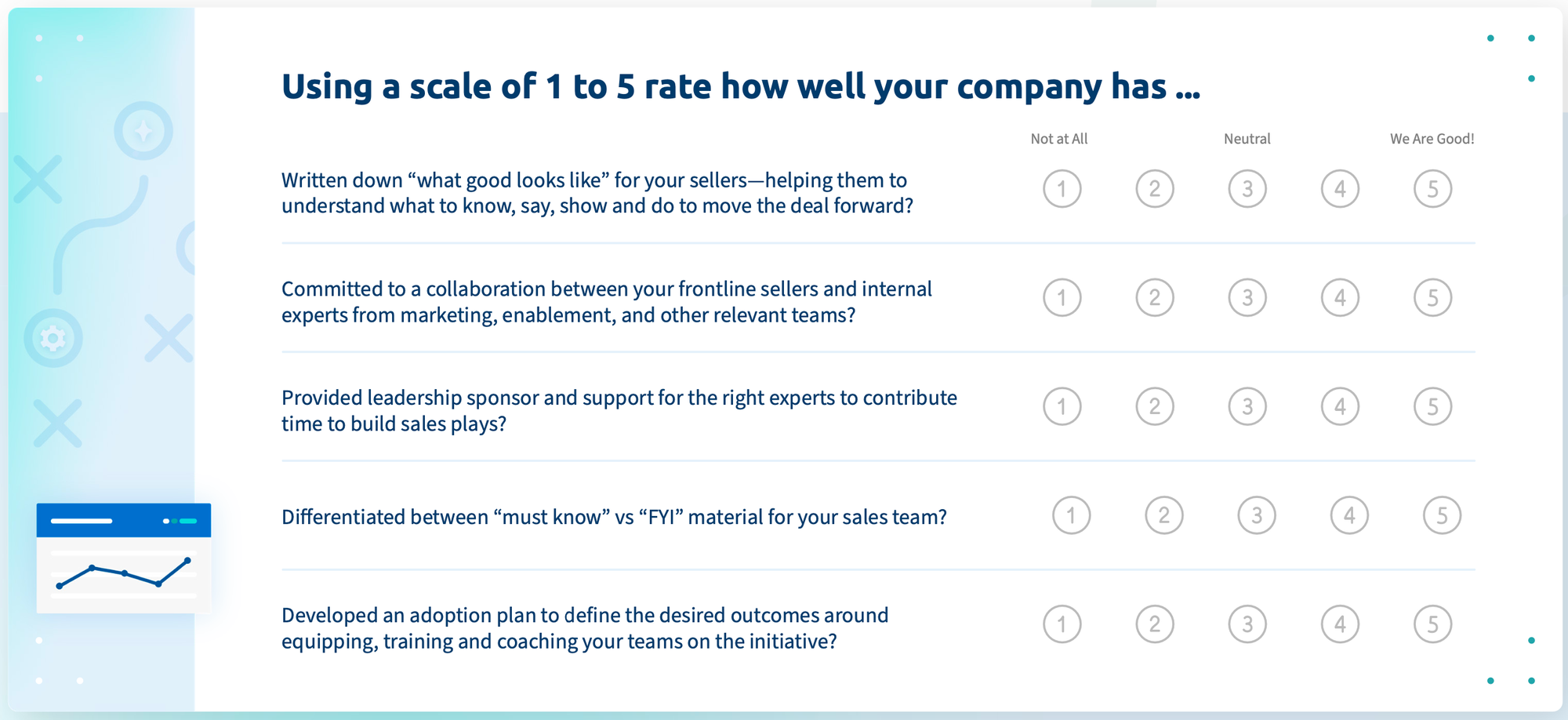
The framework
The starting point is deciding what you are trying to achieve.
You might want to drive a specific strategic initiative, such as launching a new product, deploying a new sales methodology, or moving to value selling.
Or you might want to build selling capability through a foundational program, such as improving how you onboard new sellers. In either case, the goal is to change rep behavior.
Call to action
To drive change into your sales organization, it is critical to start by clearly defining what you want your sellers to do.
You typically want to help them master key selling skills, learn knowledge essential for working effectively with customers, and engage effectively in leveraged behaviors that move the sales process forward.
Consistent execution
With a clear idea of what you want to accomplish, you can turn that into action. There are three key steps:
- First, systematically equip your sellers with the resources they need, writing down “what good looks like.”
This might involve customer- facing collateral (such as a pitch deck, brochures, and case studies), internal collateral (a demo script and tips on objection handling), and one or more sales plays (what you want your sellers to know, say, show, and do).
Success here means that sellers can say, “I get it. I know what you want me to do, and I have the tools I need to do it.”
- Then you train them through a set of learning experiences, often combining self-service and instructor-led courses, with opportunities to demonstrate their expertise.
Success means they can confidently say, “I am confident that I know how to execute.”
- Finally, you coach them on the new activities in the real world.
This is usually done by their managers, who may need support to know how to do it well. The goal is that sellers can say, “I have the support I need to be successful at this new activity with customers.”
Supporting all three of these steps, you need to analyze exactly what is—and isn’t—happening on the ground, with visualizations that help distill that data into insights you can act on.
Business outcomes
The reason you are driving change is to achieve certain outcomes. To get there, you need to get clear on what you want, what success looks like, and how you will measure it.
The more closely your metrics align to the actions you are driving in the field, the better you are able to measure the effectiveness of your enablement process.
Enablement platform
You have to have the right enablement team, tools, and processes in place to implement the Equip, Train, Coach model.
If elements of that platform are shaky or missing, you will struggle to drive change and execute effectively on your business priorities.
Looking for your next steps?
Master the fundamental pillars of sales enablement.
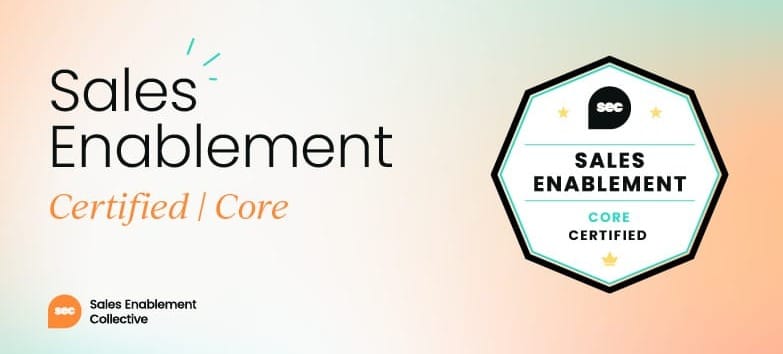
A springboard for your SE career, providing you with the skills and knowledge needed to build and maintain a world-class enablement program.
From onboarding to tech & tools, and everything in between, this course has it covered.


Sales enablement insider
Thank you for subscribing
Level up your sales enablement career & network with sales enablement experts
An email has been successfully sent to confirm your subscription.
 Follow us on LinkedIn
Follow us on LinkedIn


.png)

